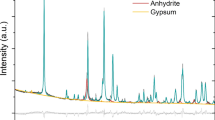Abstract
Hydration mechanisms of hydratable alumina (HA) in citric acid at different pH are investigated in this study, aiming to improve rapid hydration process and massive hydration heat. By adding citric acid to adjust solution pHs to 2, 3, and 4, the crystal phase, morphologies, and microstructure of the HA hydrates are characterized by X-ray powder diffraction (XRD), differential scanning calorimetry (TG-DSC), and transmission electron microscopy (TEM), respectively. The results show that HA exhibits different hydration behaviors in different concentrations of acidic solutions. With decreasing pH of citric acid, the crystallinity of HA decreases whereas the dehydration process slows down. Excessive citric acid could displace hydroxyl which generates from pseudoboehmite gel. Meanwhile, the excess citrate ion can be absorbed on the surface of HA by forming numerous micelles, then compound to inhibit further hydration. Proper addition of citric acid helps to delay the hydration of HA and achieve better balance between bonding performance and hydration speed.







Similar content being viewed by others
References
Cardoso, F.A., Innocentini, M.D.M., Miranda, M.F.S., et al.: Drying behavior of hydratable alumina-bonded refractory castables. J Eur Ceram Soc. 24, 797–802 (2004)
Vaidya, S.D., Thakkar, N.V.: Effect of temperature, pH and ageing time on hydration of rho alumina by studying phase composition and surface properties of transition alumina obtained after thermal dehydration. Mater Lett. 51, 295–300 (2001)
Oliveira, I.R., Ortega, F.S., Pandolfelli, V.C.: Hydration of CAC cement in a castable refractory matrix containing processing additives. Ceram Int. 35, 1545–1552 (2009)
Wan, X.G., Zhang, H.L., Liu, L.L., et al.: Controlled morphologies and growth direction of WO3 nanostructures hydrothermally synthesized with citric acid. Mater Lett. 130, 248–251 (2014)
Calvin, J.J., Asplund, M., Zhang, Y., et al.: Woodfield. Heat capacity and thermodynamic functions of boehmite (AlOOH) and silica-doped boehmite. J. Chem. Thermodynamics. 338–345 (118, 2018)
Choi, J., Yoo, K.S., Kim, S.D., et al.: Synthesis of mesoporous spherical γ-Al2O3 particles with varying porosity by spray pyrolysis of commercial boehmite. J Ind Eng Chem. 56, 151–156 (2017)
Hidber, P.C., Graule, T.J., Gauckler, L.J.: Competitive adsorption of citric acid and poly (vinyl alcohol) onto alumina and its influence on the binder migration during drying. J Am Ceram Soc. 78(7), 1775–1780 (2010)
Yang, J., Webb, A., Ameer, G.: Novel citric acid-based biodegradable elastomers for tissue engineering. Adv Mater. 16(6), 511–516 (2010)
Salim, A.A., Bidin, N., Ghoshal, S.K., et al.: Synthesis of truncated tetrahedral cinnamon nanoparticles in citric acid media via PLAL technique. Mater Lett. 217, 267–270 (2018)
Guo, Y.S., Pu, Y.P., Cui, Y.F., et al.: A simple method using citric acid as the template agent to improve photocatalytic performance of BiFeO3 nanoparticles. Mater Lett. 196, 57–60 (2017)
Salomao, R., Pandolfelli, V.C.: Citric acid as anti-hydration additive for magnesia containing refractory castables. Ceram Int. 37, 1839–1842 (2011)
Yang, C.Y., Wan, Y.S., Shih, W.H.: Effects of boehmite-coating thickness on the consolidation and rheological properties of boehmite-coated SiC suspensions. J Am Ceram Soc. 84(12), 2834–2840 (2010)
Xu, N.N., Li, Y.B., Li, S.J., et al.: Hydration mechanism and sintering characteristics of hydratable alumina with microsilica addition. Ceram Int. 45(11), 13607–14480 (2019)
Kumar, R.S., Khanra, A.K., Johnson, R.: Processing and properties of sintered submicron IR transparent alumina derived through sol–gel method. J Sol-gel Sci Techn. 86(2), 374–382 (2018)
Lange, R.S.A.D., Hekkink, J.H.A., Keizer, K., et al.: Formation and characterization of supported microporous ceramic membranes prepared by sol-gel modification techniques. J Membrane Sci. 99(1), 57–75 (2017)
Kwon, S., Messing, G.L.: Sintering of mixtures of seeded boehmite and ultrafine α-alumina. J Am Ceram Soc. 83(1), 82–88 (2010)
Jiao, W.Q., Yue, M.B., Wang, Y.M., et al.: Synthesis of morphology-controlled mesoporous transition aluminas derived from the decomposition of alumina hydrates. Micropor Mesopor Mat. 147(1), 167–177 (2012)
Kim, S.W., Iwamoto, S., Inoue, M.: Pore structure of alumina derived from the alkyl derivatives of boehmite. Adv Sci Tech. 45(5), 6–11 (2006)
Geng, Z., Ma, L.L., Li, Z.Y., et al.: Citric acid and lactic acid have a synergetic effect on absorbing the bone mineral crystal. Mater Lett. 215, 218–220 (2017)
Han, Q., Wu, X.F., Liao, Y.C., et al.: The structural evolution of hollow boehmite particles induced by citric acid. Mater Lett. 95, 9–12 (2013)
Funding
The study is financially supported by National Natural Science Foundation of China (nos. 51772221 and 51502213) and Key Program of Natural Science Foundation of Hubei Province (China, 2017CFA004).
Author information
Authors and Affiliations
Corresponding author
Additional information
Publisher’s note
Springer Nature remains neutral with regard to jurisdictional claims in published maps and institutional affiliations.
Rights and permissions
About this article
Cite this article
Xu, N., Li, Y., Li, S. et al. Controlled morphologies and hydration process of hydratable alumina by using citric acid. J Aust Ceram Soc 56, 1427–1433 (2020). https://doi.org/10.1007/s41779-020-00483-z
Received:
Revised:
Accepted:
Published:
Issue Date:
DOI: https://doi.org/10.1007/s41779-020-00483-z




